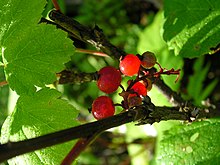Loading AI tools
Berry and plant From Wikipedia, the free encyclopedia
Ribes triste, known as the northern redcurrant,[2] swamp redcurrant, or wild redcurrant,[3] is an Asian and North American shrub in the gooseberry family. It is widespread across Canada and the northern United States, as well as in eastern Asia (Russia, China, Korea, Japan).[4][5]
| Ribes triste | |
|---|---|
 | |
 | |
| Scientific classification | |
| Kingdom: | Plantae |
| Clade: | Tracheophytes |
| Clade: | Angiosperms |
| Clade: | Eudicots |
| Order: | Saxifragales |
| Family: | Grossulariaceae |
| Genus: | Ribes |
| Species: | R. triste |
| Binomial name | |
| Ribes triste | |
| Synonyms[1] | |
| |
Ribes triste grows in wet rocky woods, swamps, and cliffs. It grows to 50 cm (20 in) tall, with a lax, often creeping branches. The leaves are alternate, palmately lobed with five lobes, 6–10 cm (2+1⁄4–4 in) in diameter. The flowers are in pendulous racemes, 4–7 cm (1+1⁄2–2+3⁄4 in) long. The axis of the raceme is glandular. Each raceme bears 6-13 small, purplish flowers that appear in June and July. The fruit is a bright red berry, without the hairs that some currants have. The fruit is edible but rather sour.[6]
It is listed as endangered in Connecticut[7] and Ohio, and as threatened in Pennsylvania.[8]
Ribes is listed a plant pest in Michigan and the planting of it in certain parts of the state is prohibited.[8]
Alaska Natives use the fruit as food, eating it raw, and making the berries into jam and jellies.[9] Eskimos eat the berries[10] and the Inupiat eat them raw or cooked, mix them with other berries which are used to make a traditional dessert. They also mix the berries with rosehips and highbush cranberries and boil them into a syrup.[11] The Iroquois mash the fruit, make them into small cakes, and store them for future use. They later soak the fruit cakes in warm water and cooked them a sauce or mixed them with corn bread. They also sun dry or fire dry the raw or cooked fruit for future use and take the dried fruit with them as a hunting food.[12] The Ojibwe eat the berries raw, and also preserve them by cooking them, spreading them on birch bark into little cakes, which are dried and stored for winter use.[13] In the winter, they often eat the berries with cooked with sweet corn. They also use the berries to make jams and preserves.[14] The Upper Tanana eat the berries as food.[15]
The Ojibwe take a decoction of the root and stalk for 'gravel',[16] and take a compound decoction of the stalk for 'stoppage of periods',[17] and use the leaves as a 'female remedy'.[18] The Upper Tanana use a decoction of the stems, without the bark, as a wash for sore eyes.[15]
Seamless Wikipedia browsing. On steroids.
Every time you click a link to Wikipedia, Wiktionary or Wikiquote in your browser's search results, it will show the modern Wikiwand interface.
Wikiwand extension is a five stars, simple, with minimum permission required to keep your browsing private, safe and transparent.